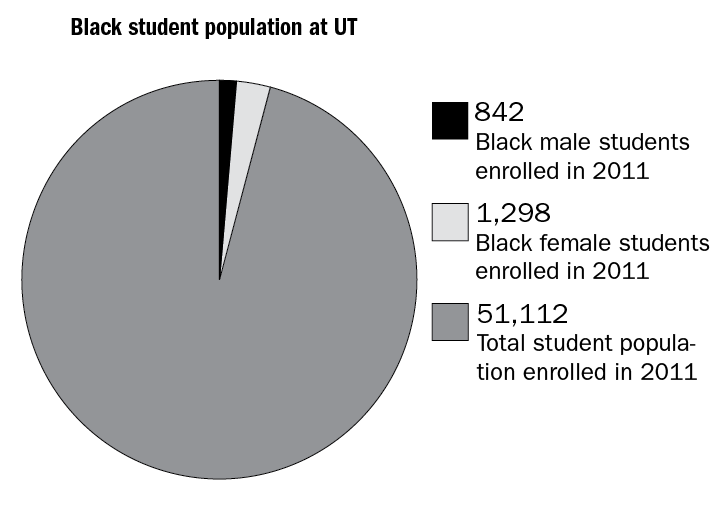On Nov. 4, Sy Stokes, an African-American male student at UCLA, uploaded a video to YouTube entitled “The Black Bruins [Spoken Word].” In the video, Stokes and nine other black male students at the school address the lack of diversity in UCLA’s undergraduate student population in chilling spoken word poetry.
In the video, Stokes reveals that black males make up only 3.3 percent of the student population at UCLA, and that 65 percent of those black males are student-athletes. He goes on to imply that UCLA only cares about increasing diversity if it helps the school win national championships.
The video is so startling that it’s tempting to pretend that problems with racial diversity are unique to UCLA. But the numbers at UT tell a different story, and unfortunately for the black male students at UT, it’s even worse.
In the fall of 2011, the University had a total black male enrollment of 842 students. That’s approximately 39 percent of the total black population and about 1.6 percent of UT’s total population.
Sharon Davies, executive director of the Kirwan Institute for the Study of Race and Ethnicity at Ohio State University, found that out of the 7,199 freshmen enrolled in 2009, a startling 129 of them were black males.
And, of those few African-American males, only 78 were predicted to graduate as the graduation rate for African-American males at UT is only 60 percent.
It gets worse: The University of Pennsylvania’s Center for the Study of Race and Equity in Education found a 66 percent difference between the percentage of players on the UT football and basketball teams that are black and the percentage of black men in the total undergraduate student body — the highest such difference in the Big 12 Conference.
UT’s 1.6 percent black male presence is even lower than UCLA’s 3.3 percent, so this is clearly an area where improvement is needed.
Overall, UT is perceived as diverse, and rightfully so. But these low levels of black male representation make clear that there is still much progress to be made, even at “diverse” schools.
Student Government Vice President Ugeo Williams, one of the black students at UT, said he has completed research focused on the cohort of black men who entered UT in the fall of 2011.
“If we take a deeper look into University data, most times, African-American male students are one of the lowest groups represented at a university equivalent to the size of UCLA and UT,” Williams said.
Williams said that he wonders if non-athlete black men are applying at high rates and just not being admitted or if non-athletes are being admitted but not receiving the same financial support as black male athletes.
I asked Marcus Hutchins, a third-year offensive lineman on the UT football team and a physical culture and sports junior, whether the claim that UCLA strives for “diversity” only insofar as it increases national championships holds true at UT.
Hutchins replied, “To a certain extent, yes … but at the same time, we [student-athletes] get punished for not going to class and study hall or missing a group meeting.”
Despite the low number of black males at UT, Hutchins doesn’t feel isolated as a minority.
“I feel I have every chance as my other race counterparts to compete at this University for a degree.”
Undeclared freshman Derek Orji, also a black male, said, “I don’t feel isolated because there are a lot of ethnic communities on campus.”
But with UT’s holistic admissions policy in which race is a factor currently being reviewed by the United States Court of Appeals for the Fifth Circuit, we can’t be blind to the low number of black men attending UT.
Since Stokes’ video was posted on Nov. 4, it has been viewed more than 1,480,000 times. The video made its way to The Huffington Post and even provoked a response from Don Lemon, a black “CNN Newsroom” anchor. Though the video centers on UCLA, it’s apparent that the issue of low black male representation applies to UT as well.
“The video is well done and it serves as a catalyst for starting a conversation. The question is how does this issue get resolved,” said Philemon Brown, president of the UT Black Faculty and Staff Association.
“We live in a time that many people deny issues of race exist and everything is equal,” Brown said. “That is a part of the fallacy.”
Johnson is an undeclared junior from DeSoto.





















